Marine Diesel Engine Exhaust Emissions Measured in Ship’s Dynamic Operating Conditions
Abstract
1. Introduction
- Is it possible to measure and calculate the emissions of the composition of exhaust gases in dynamic operating conditions of marine diesel engine, taking into account the distance travelled?
- Is it possible to use a low-calculation method for modeling the emissions of the composition of exhaust gases in the dynamic operating conditions of the ship’s propulsion system?
2. Materials and Methods
2.1. Research Object
- -
- Rotating speed sensor,
- -
- fuel rack sensor, and
- -
- inclinometer.
2.2. Measurement Site
- Wind direction and strength: NW—4,
- sea state: 3,
- atmospheric pressure: 1017 hPa, and
- air temperature: +5 °C.
2.3. A Neural Network
2.4. The Durbin–Watson Test
- if = 2, there is no correlation,
- if > 2, then
- ◦
- if > 4 − , there is a negative correlation,
- ◦
- if 4— 4 − , no conclusion/decision,
- ◦
- if < 4 − , no correlation,
- if < 2, then
- ◦
- if < , there is a positive correlation,
- ◦
- if , no conclusion/decision,
- ◦
- if < 4 − , no correlation,
2.5. The Emission of the Composition of Exhaust Gases in Dynamic States
3. Results
- Stage 1—unberthing and hauling off maneuver,
- stage 2—moving off maneuver,
- stage 3—change of direction maneuver, and
- stage 4—acceleration maneuver.
4. Conclusions
- Carrying out tests of multi-engine propulsion system, the measurement set should be extended with additional sensors and an exhaust gases analyzer allowing for the parallel measurement of all engines.
- Approximation with the use of neural networks gives exact results of the fit, that was confirmed by the analysis of regression residuum using the Durbin–Watson test.
- The learned neural networks will be used to estimate the emissions of exhaust gases in a model of ship’s propulsion. This solution will enable to build enhanced model that will estimate emission in port and coastal areas traffic.
- The ship’s route emissions for a vessel maneuvering at place or at low speed are higher than for vessels realizing passage at cruising speeds.
- Active slowing down (not described in the paper) involving the operation of the propulsion system “backwards” while the unit is moving forward, also increases the value of the ship’s route emissions than in the case of passive slowing down of the ship.
- In the experiment, the position was recorded using the GPS system. The assumption was to obtain the sampling time every 1 s. In future works, the AIS system collecting information about the movement of vessels in the port will be used. This will allow the emissions of ships maneuvering in port areas to be calculated. However, the system registration time is longer than the direct GPS measurement.
Author Contributions
Funding
Conflicts of Interest
References
- Saxe, H.; Larsen, T. Air pollution from ships in three Danish ports. Atmos. Environ. 2004, 38, 4057–4067. [Google Scholar] [CrossRef]
- Zhang, Y.; Yang, X.; Brown, R.; Yang, L.; Morawska, L.; Ristovski, Z.; Fu, Q.; Huang, C. Shipping emissions and their impacts on air quality in China. Sci. Total Environ. 2017, 581, 186–198. [Google Scholar] [CrossRef] [PubMed]
- Sorte, S.; Rodrigues, V.; Borrego, C.; Monteiro, A. Impact of harbour activities on local air quality: A review. Environ. Pollut. 2020, 257, 113542. [Google Scholar] [CrossRef] [PubMed]
- Chen, D.; Zhao, Y.; Nelson, P.; Li, Y.; Wang, X.; Zhou, Y.; Lang, J.; Guo, X. Estimating ship emissions based on AIS data for port of Tianjin, China. Atmos. Environ. 2016, 145, 10–18. [Google Scholar] [CrossRef]
- Merk, O. Shipping Emissions in Ports. Int. Transp. Forums Discuss. Pap. 2014. [Google Scholar] [CrossRef]
- Dragović, B.; Tzannatos, E.; Tselentis, V.; Meštrović, R.; i Škurić, M. Ship emissions and their externalities in cruise ports. Transp. Res. Part D Transp. Environ. 2018, 61, 289–300. [Google Scholar] [CrossRef]
- Moreno-Gutiérrez, J.; Pájaro-Velázquez, E.; Amado-Sánchez, Y.; Rodríguez-Moreno, R.; Calderay-Cayetano, F.; Durán-Grados, V. Comparative analysis between different methods for calculating on-board ship’s emissions and energy consumption based on operational data. Sci. Total Environ. 2019, 650, 575–584. [Google Scholar]
- Toscano, D.; Murena, F. Atmospheric ship emissions in ports: A review. Correlation with data of ship traffic. Atmos. Environ. 2019, 4, 100050. [Google Scholar] [CrossRef]
- Aulinger, A.; Matthias, V.; Bieser, J.; Quante, M. Effects of Future Ship Emissions in the North Sea on Air Quality; Springer: Berlin/Heidelberg, Germany, 2014. [Google Scholar]
- Sea Shipping Emission 2014; Final Report; Marin: Bilthoven, The Netherlands, 2016.
- Sea Shipping Emission 2017; Final Report; Marin: Bilthoven, The Netherlands, 2019.
- Markowski, J.; Pielecha, J.; Jasiński, R. Model to Assess the Exhaust Emissions from the Engine of a Small Aircraft during Flight. Procedia Eng. 2017, 192, 557–562. [Google Scholar] [CrossRef]
- IMO. MARPOL 73/78: The International Convention for the Prevention of Pollution from Ships. Available online: https://www.imo.org/en/About/Conventions/Pages/International-Convention-for-the-Prevention-of-Pollution-from-Ships-(MARPOL).aspx (accessed on 6 November 2020).
- IMO. MARPOL ANNEX VI and the Act to Prevent Pollution from Ships. Available online: https://www.epa.gov/enforcement/marpol-annex-vi-and-act-prevent-pollution-ships-apps (accessed on 6 November 2020).
- Čampara, L.; Hasanspahić, N.; Vujičić, S. Overview of MARPOL ANNEX VI regulations for prevention of air pollution from marine diesel engines. SHS Web Conf. 2018, 58, 5–6. [Google Scholar] [CrossRef]
- Sys, C.; Vanelslander, T.; Adriaenssens, M.; Van Rillaer, I. International emission regulation in sea transport: Economic feasibility and impact. Transp. Res. Part D Transp. Environ. 2016, 45, 139–151. [Google Scholar] [CrossRef]
- IMO Working Group Agrees Further Measures to Cut Ship Emissions. Available online: https://www.imo.org/en/MediaCentre/PressBriefings/pages/36-ISWG-GHG-7.aspx (accessed on 6 November 2020).
- Domínguez-Sáez, A.; Rattá, G.A.; Barrios, C.C. Prediction of exhaust emission in transient conditions of a diesel engine fueled with animal fat using Artificial Neural Network and Symbolic Regression. Energy 2018, 149, 675–683. [Google Scholar] [CrossRef]
- Documentation of Project 874 Hydrographic Ship; MW: Gdynia, Poland, 2001.
- Testo 350 Maritime, Instruction Manual; Testo: Lenzkirch, Germany, 2010.
- GPS Mouse User’s Guide V1.0; GlobalSat Technlogy Corp: New Taipei City, Taiwan, 2011.
- Piezotron Quartz Pressure Sensor Type 7613B for Engine Diagnostics; The Kistler Group: Winterthur, Switzerland, 2013.
- Multifunction DAQ USB Module USB-47111A; Advant. Tech. Ldt: Cincinnati, OH, USA, 2015.
- OCOE 02581 Datasheet; Optom: Warsaw, Poland, 2015.
- Linear Potentiometer LPF Datasheet; Ixthus Instrum.: Towcester, UK, 2019.
- Kubler 8.IS40.23321 Inclinometer Datasheet; Kubler Gr.: Villingen-Schwenningen, Germany, 2015.
- Kodosky, J. LabVIEW. Proc. ACM Program. Lang. 2020. [Google Scholar] [CrossRef]
- Kwon, S.J. Artificial neural networks. Artif. Intel. Rob. 2011. [Google Scholar] [CrossRef][Green Version]
- Chatfield, C. Durbin-Watson Test. Wiley StatsRef Stat. Ref. Online 2014. [Google Scholar] [CrossRef]
- StatSoft, Inc. STATISTICA (Data Analysis Software System), Version 6; StatSoft, Inc.: Tulsa, OK, USA, 2001. [Google Scholar]
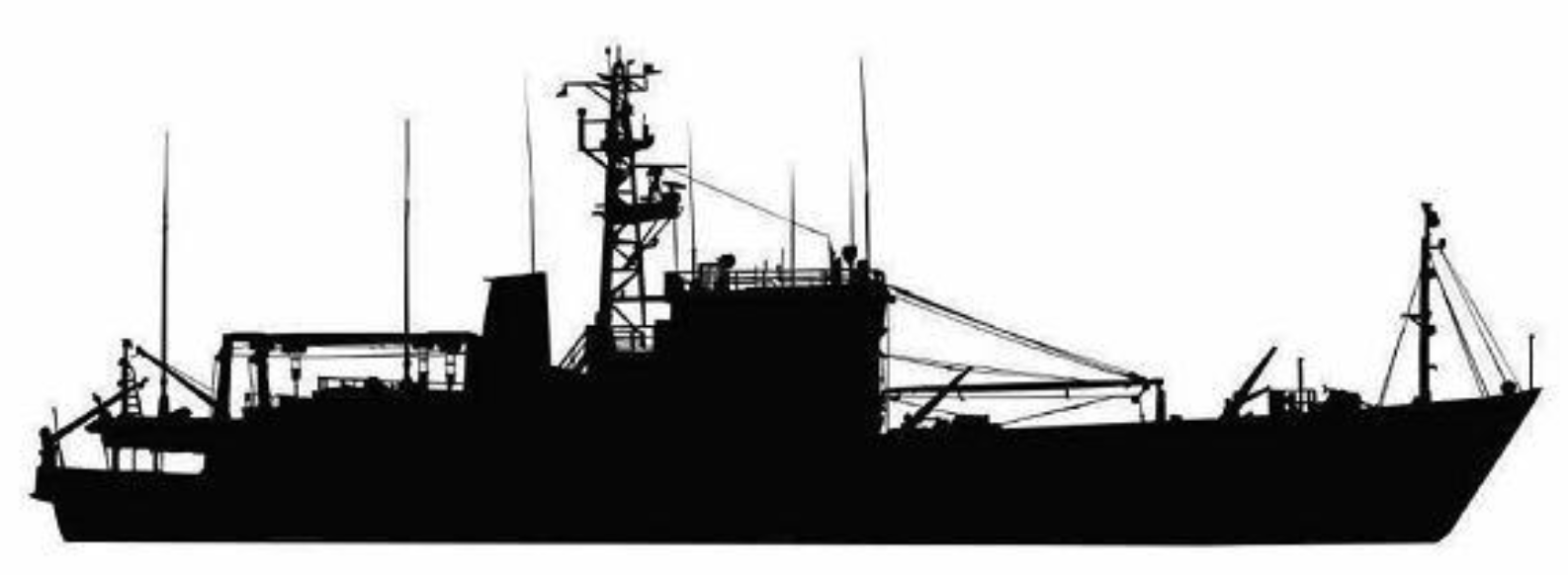
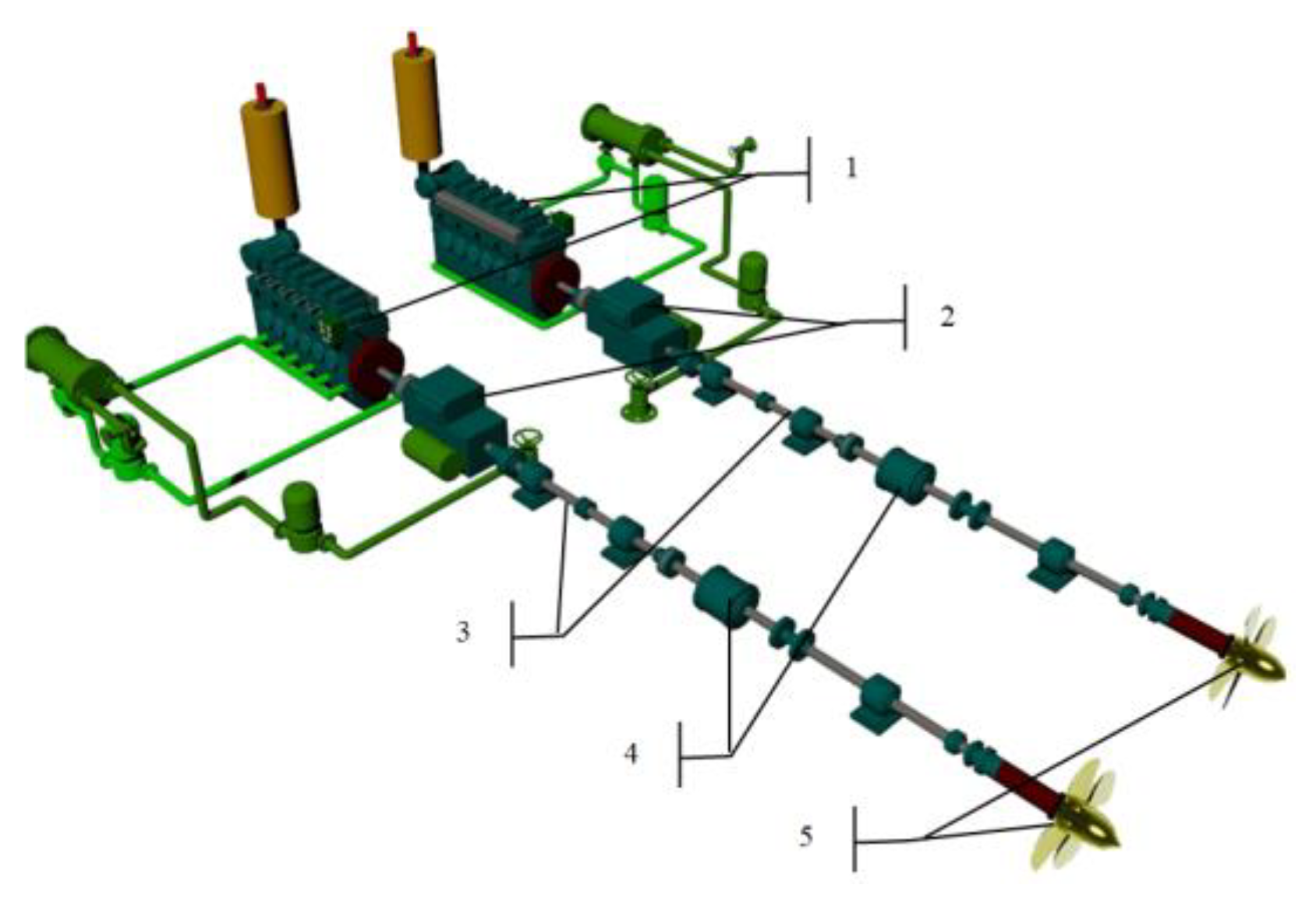
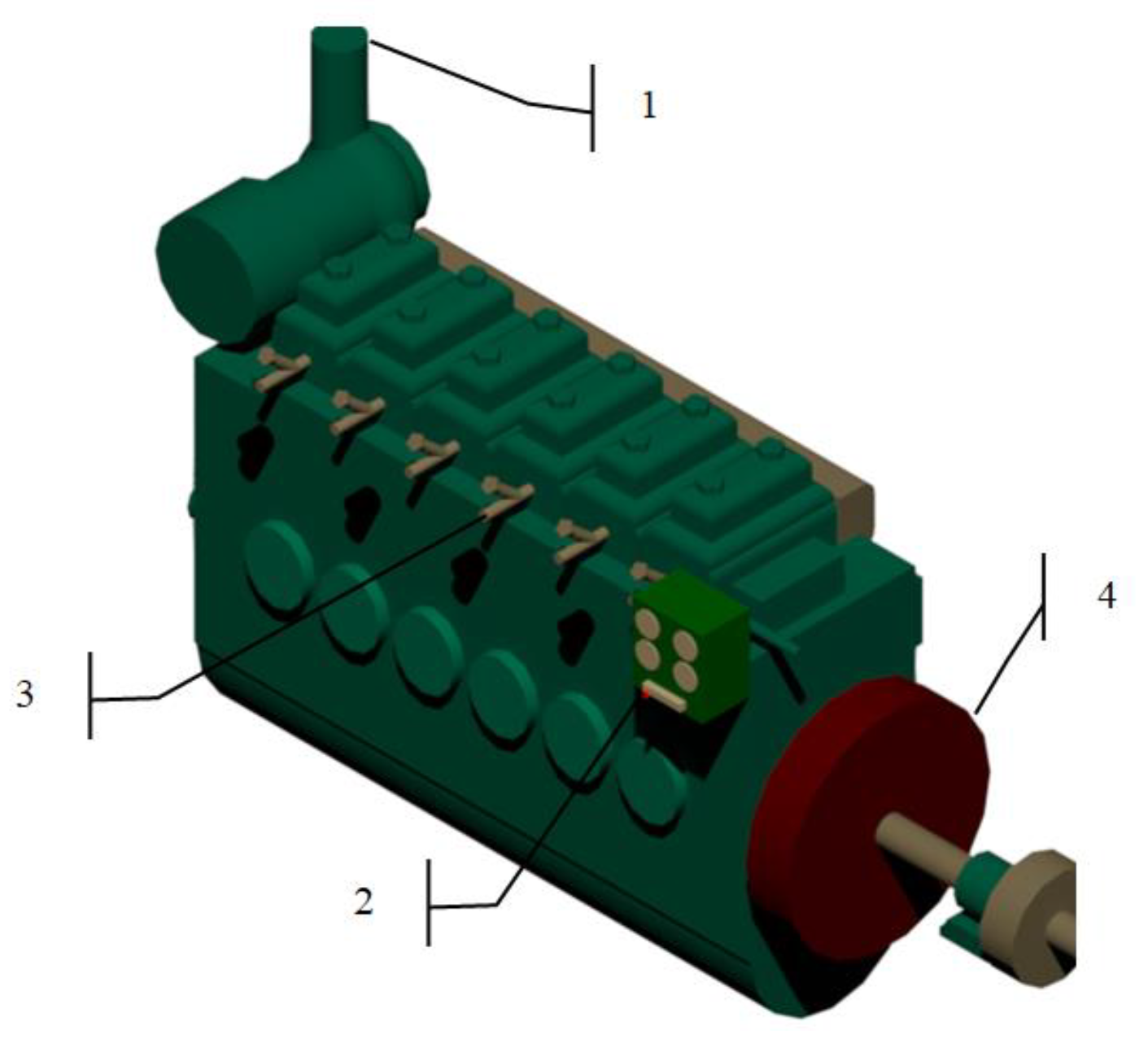
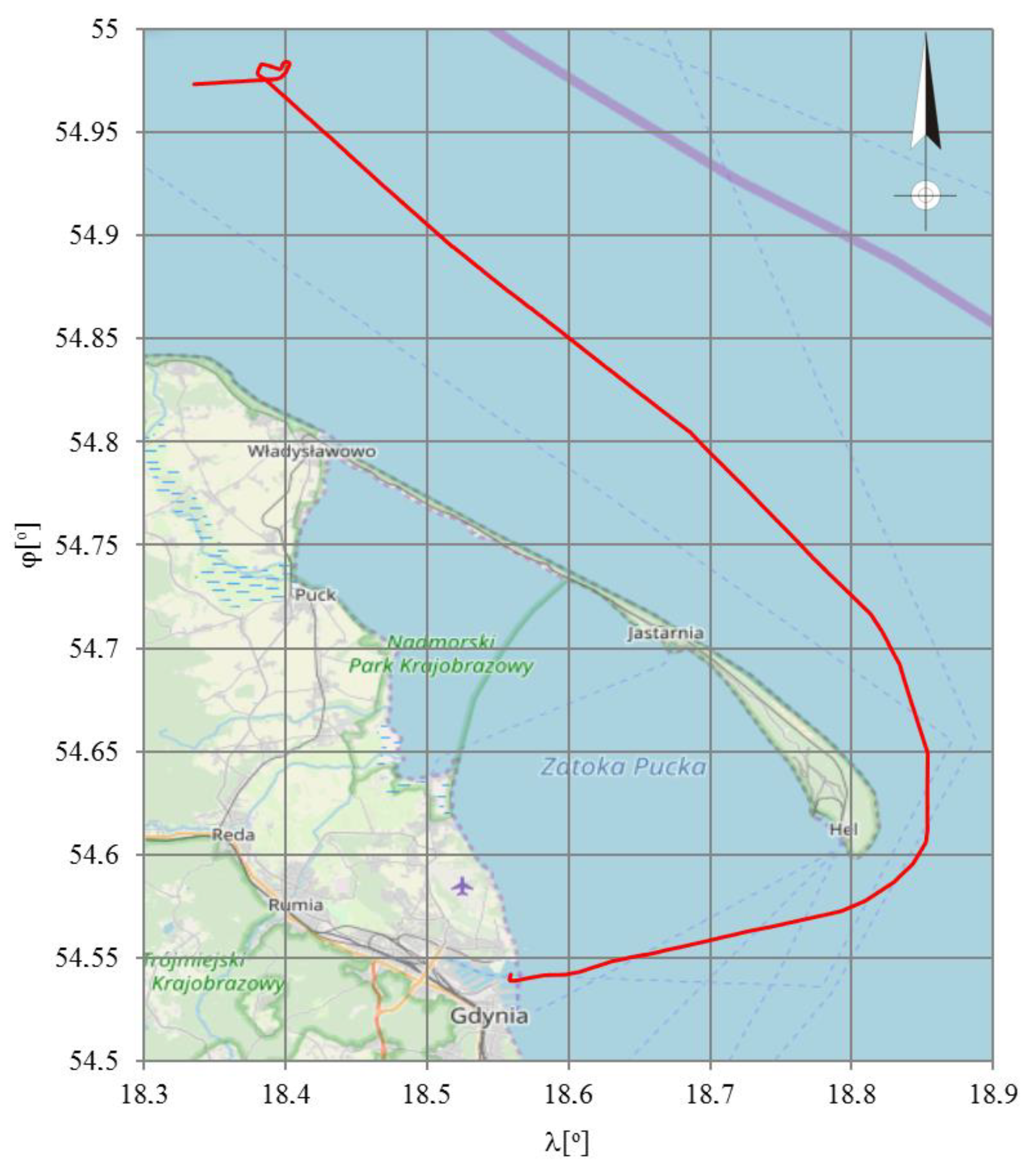
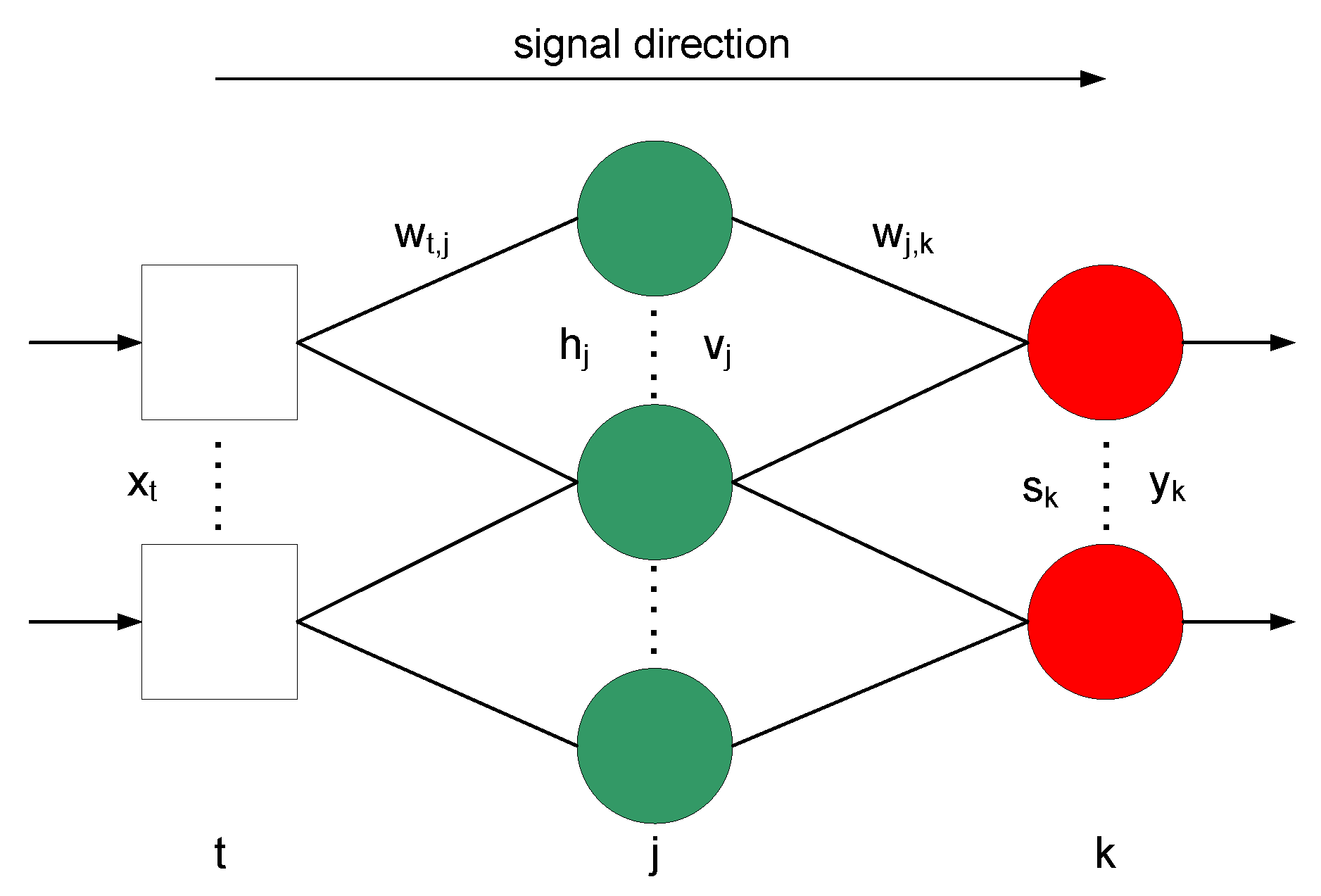
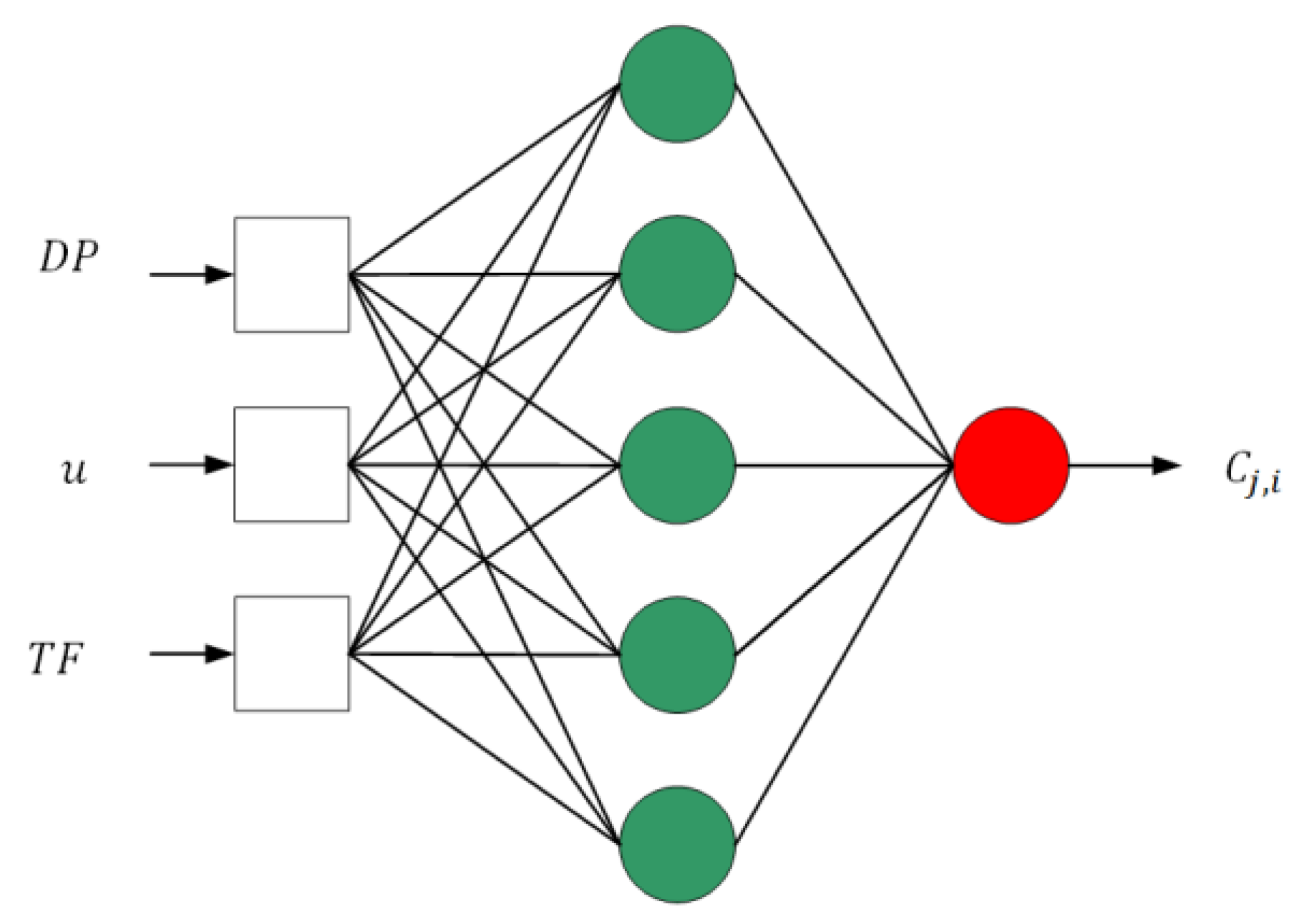
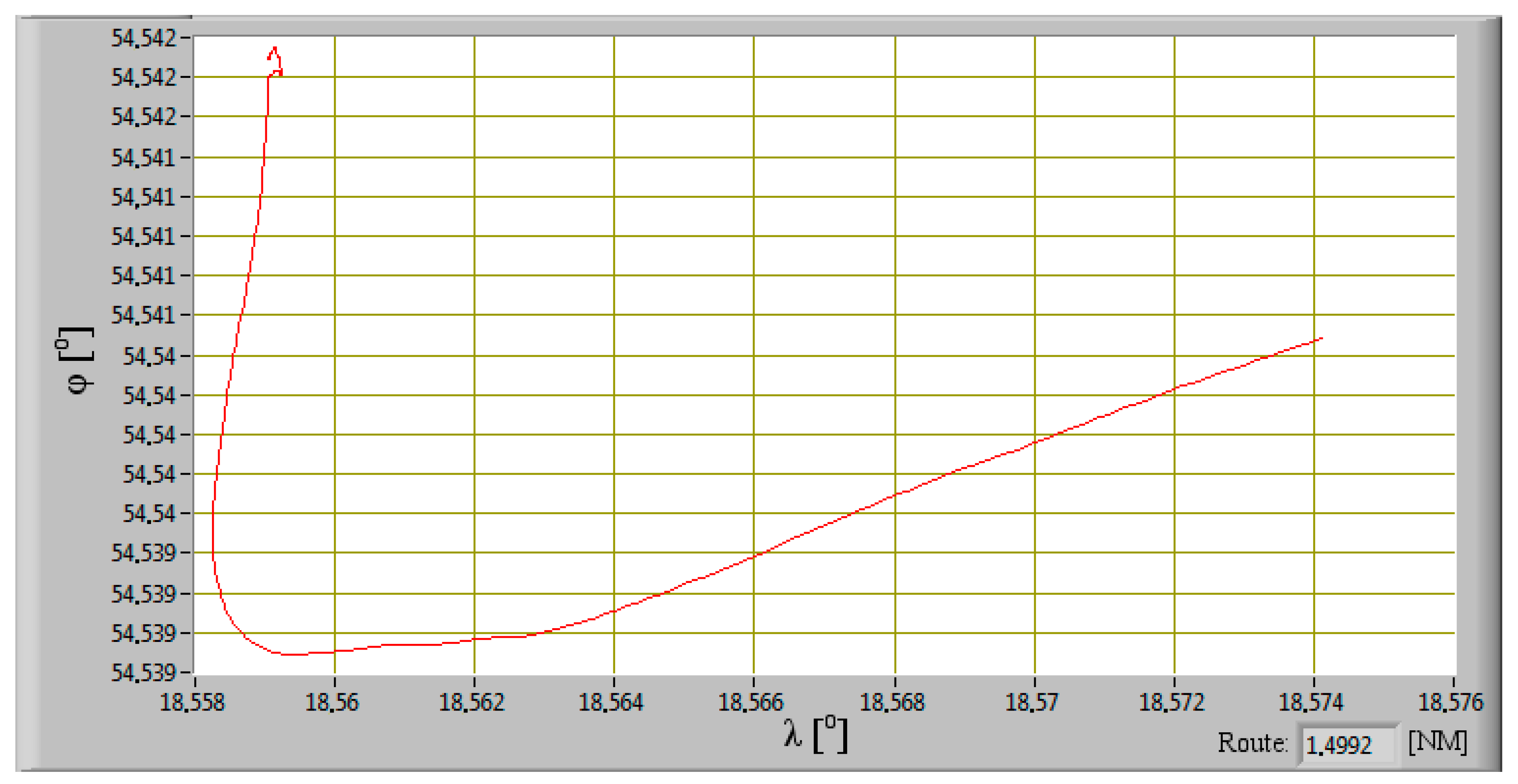


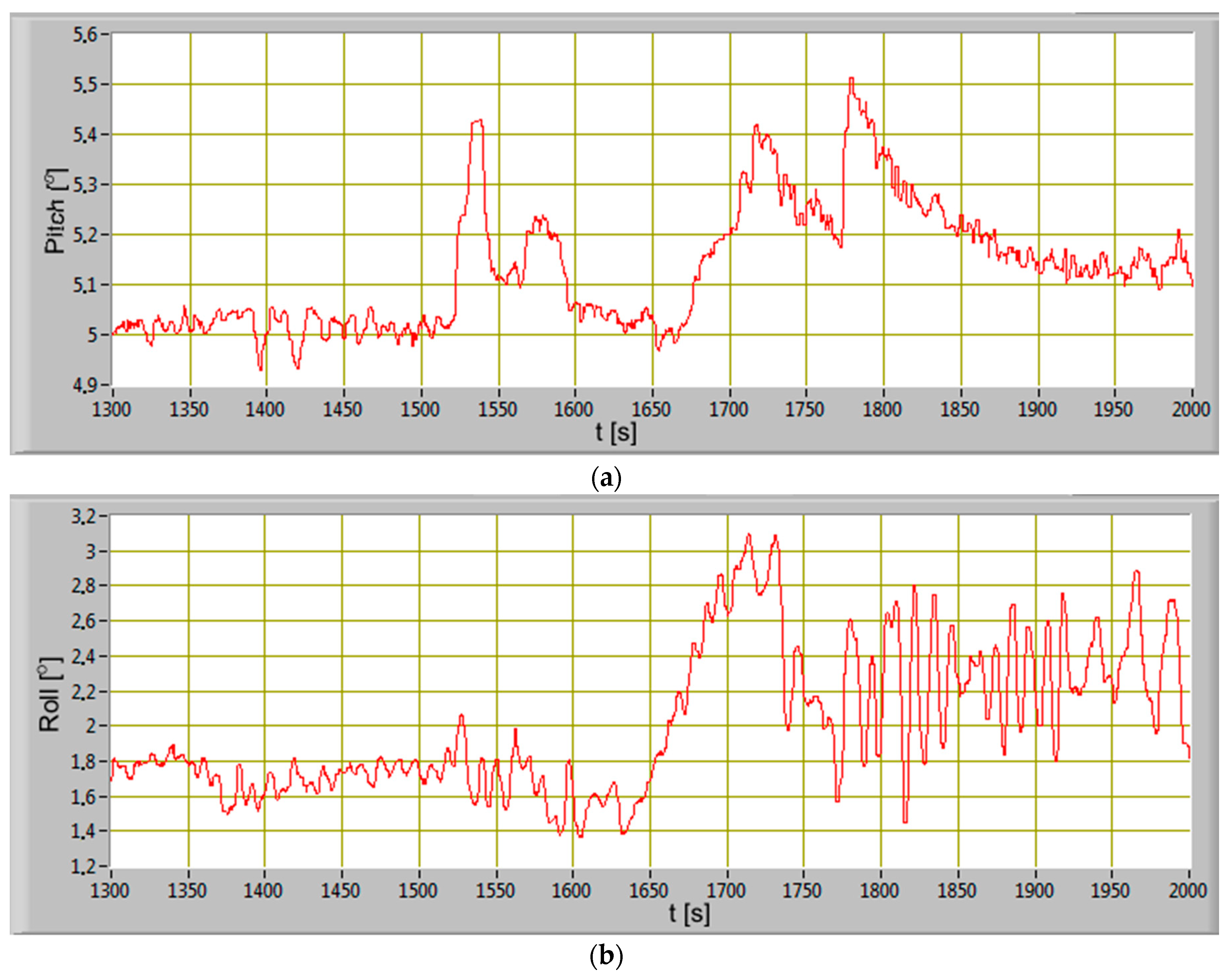
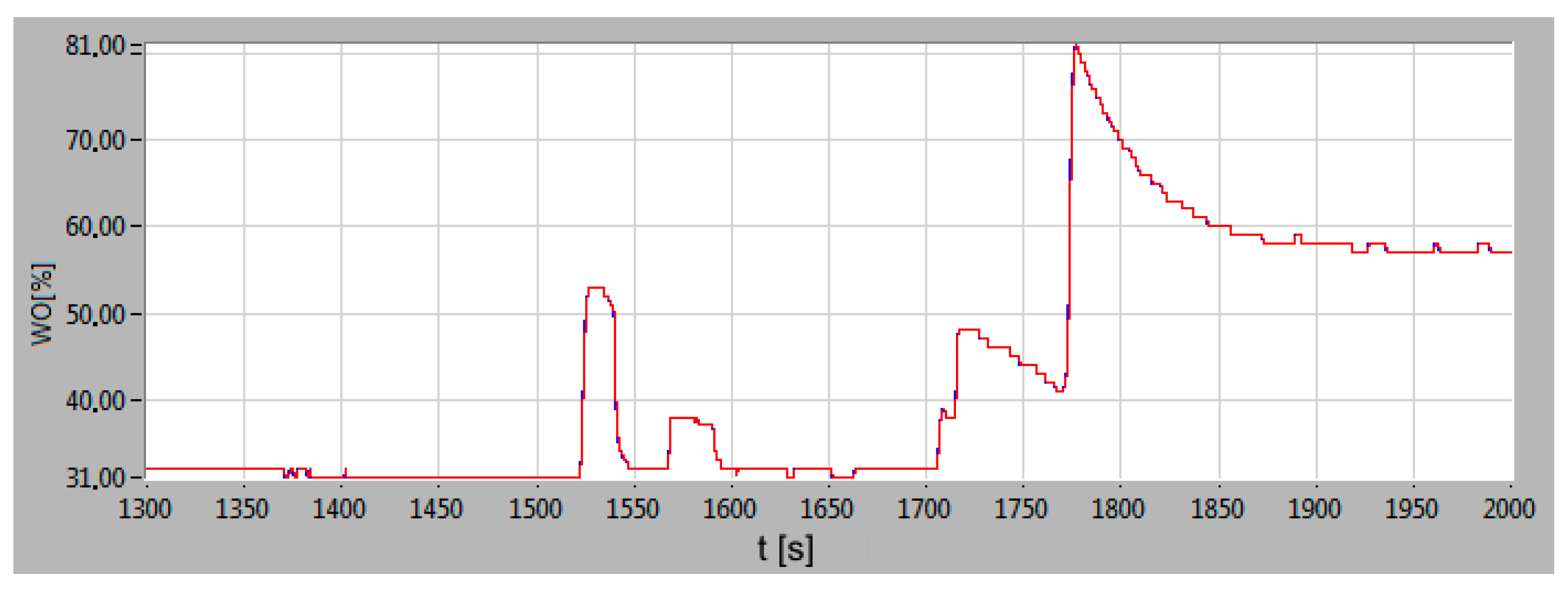
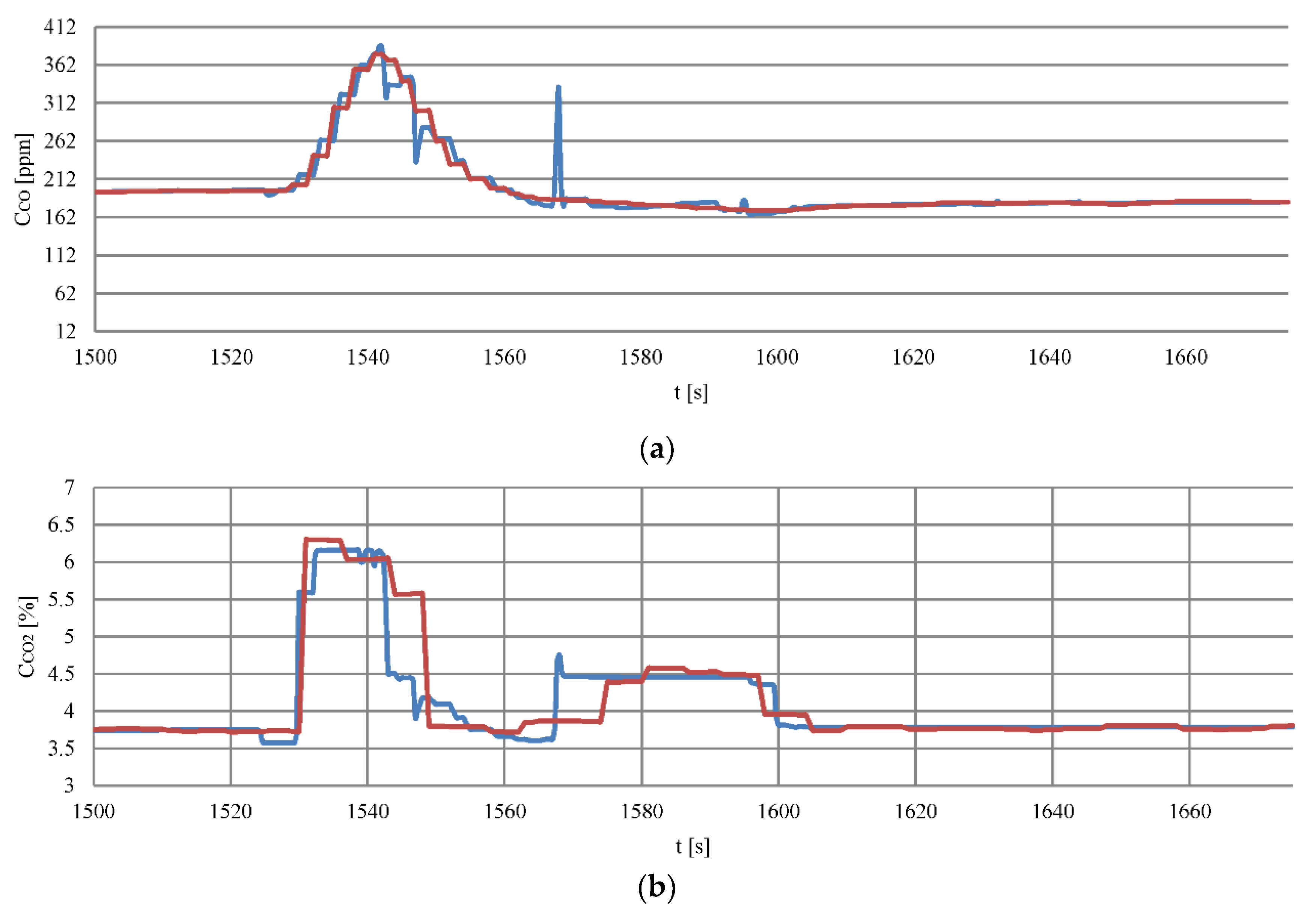
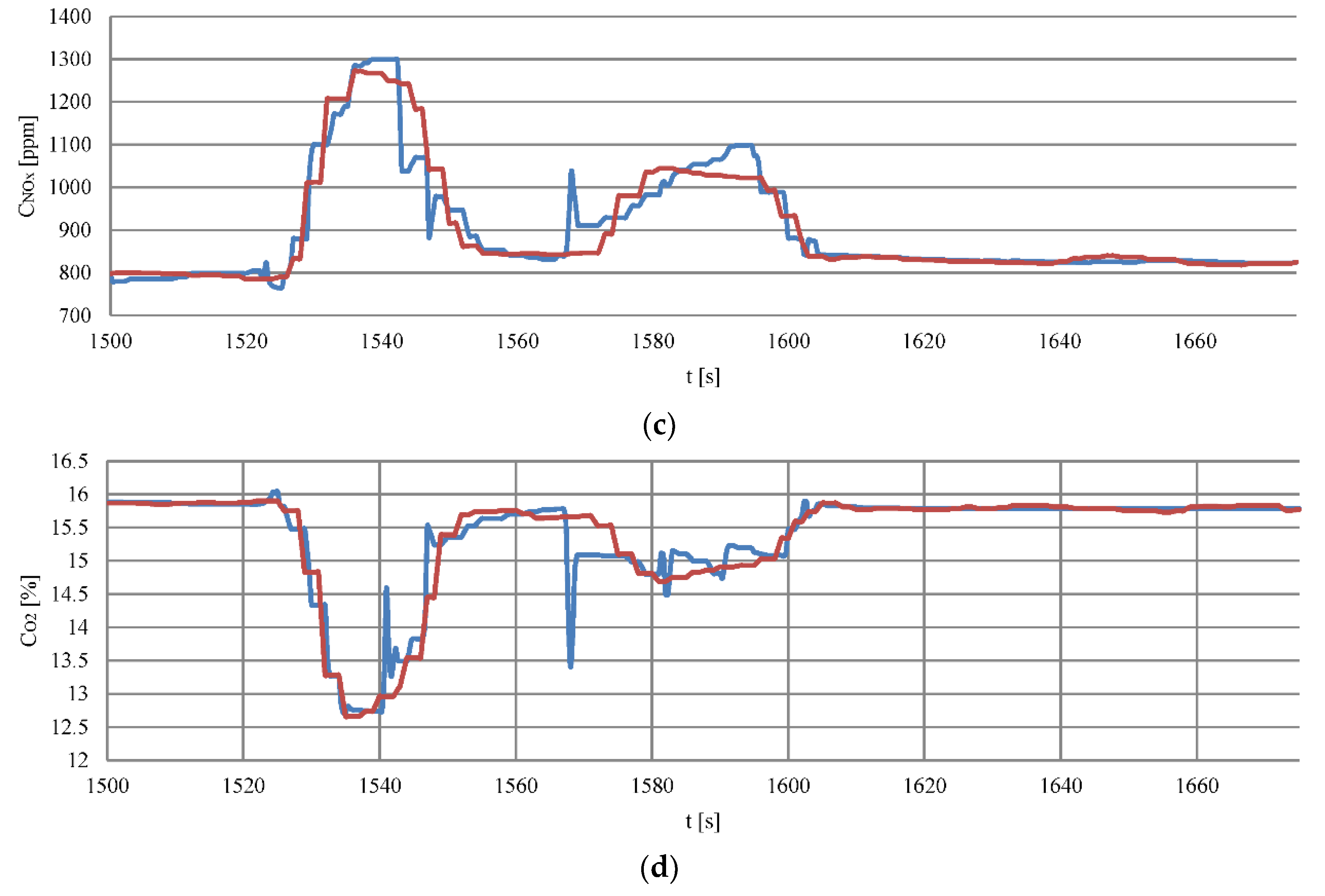
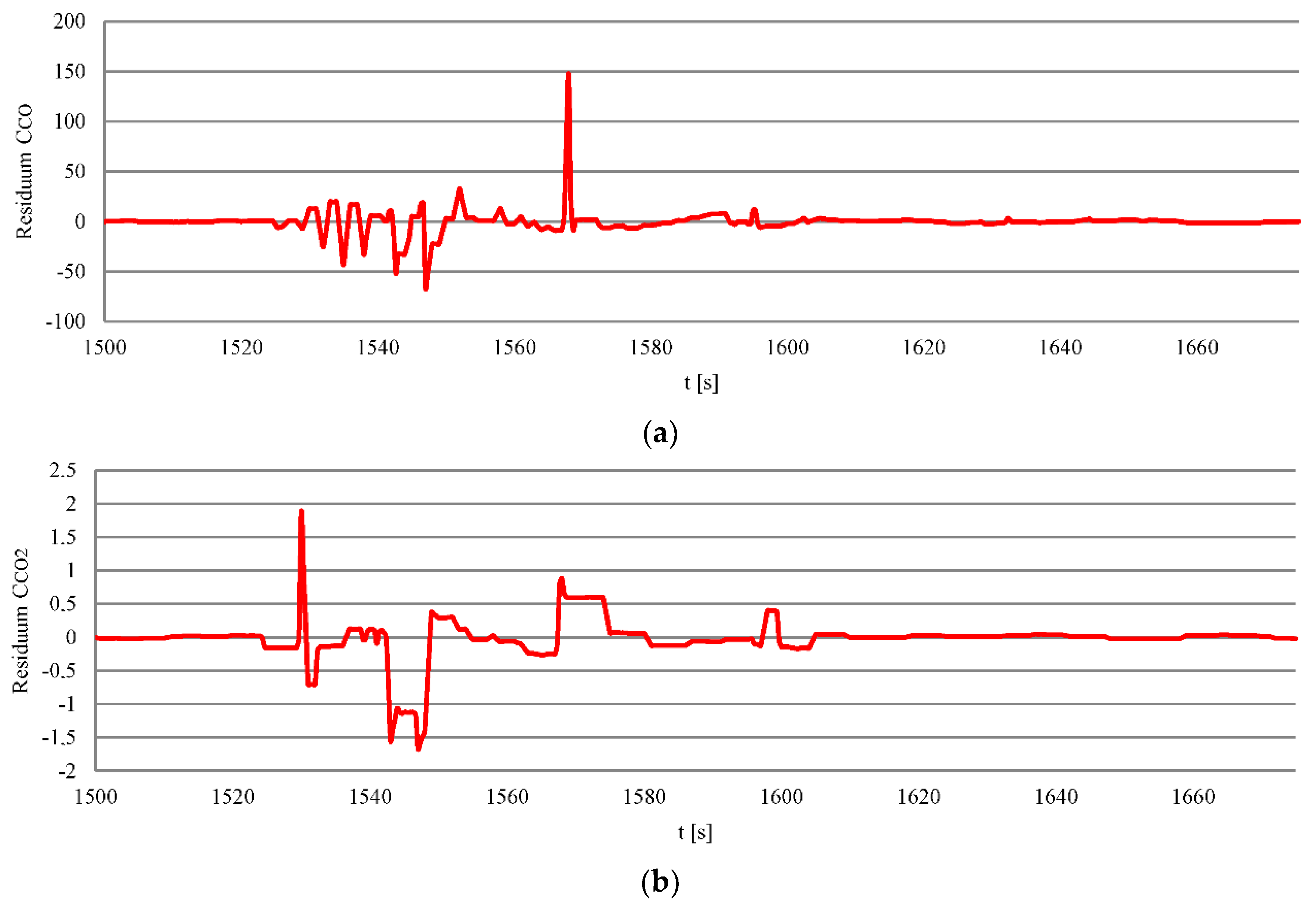
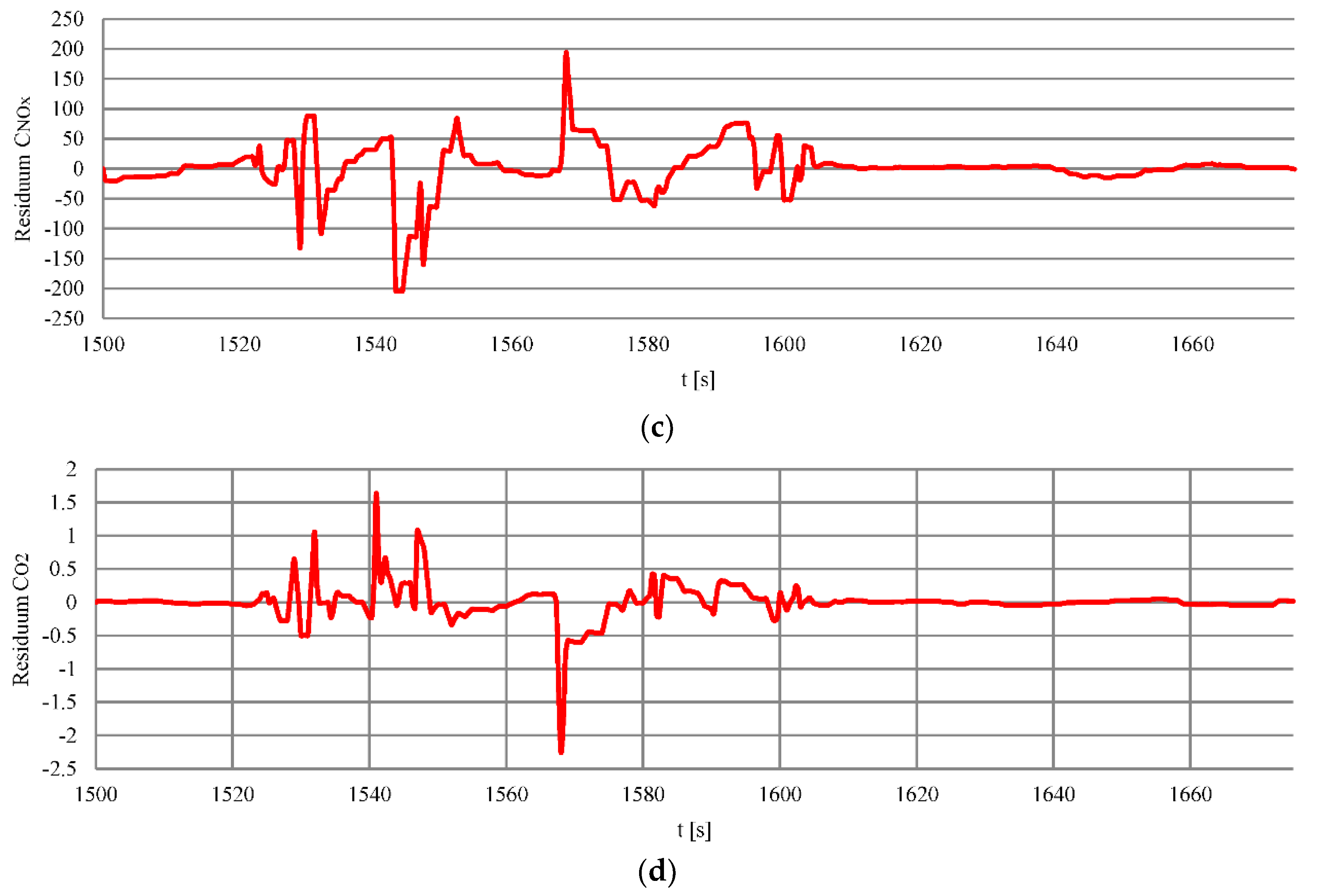
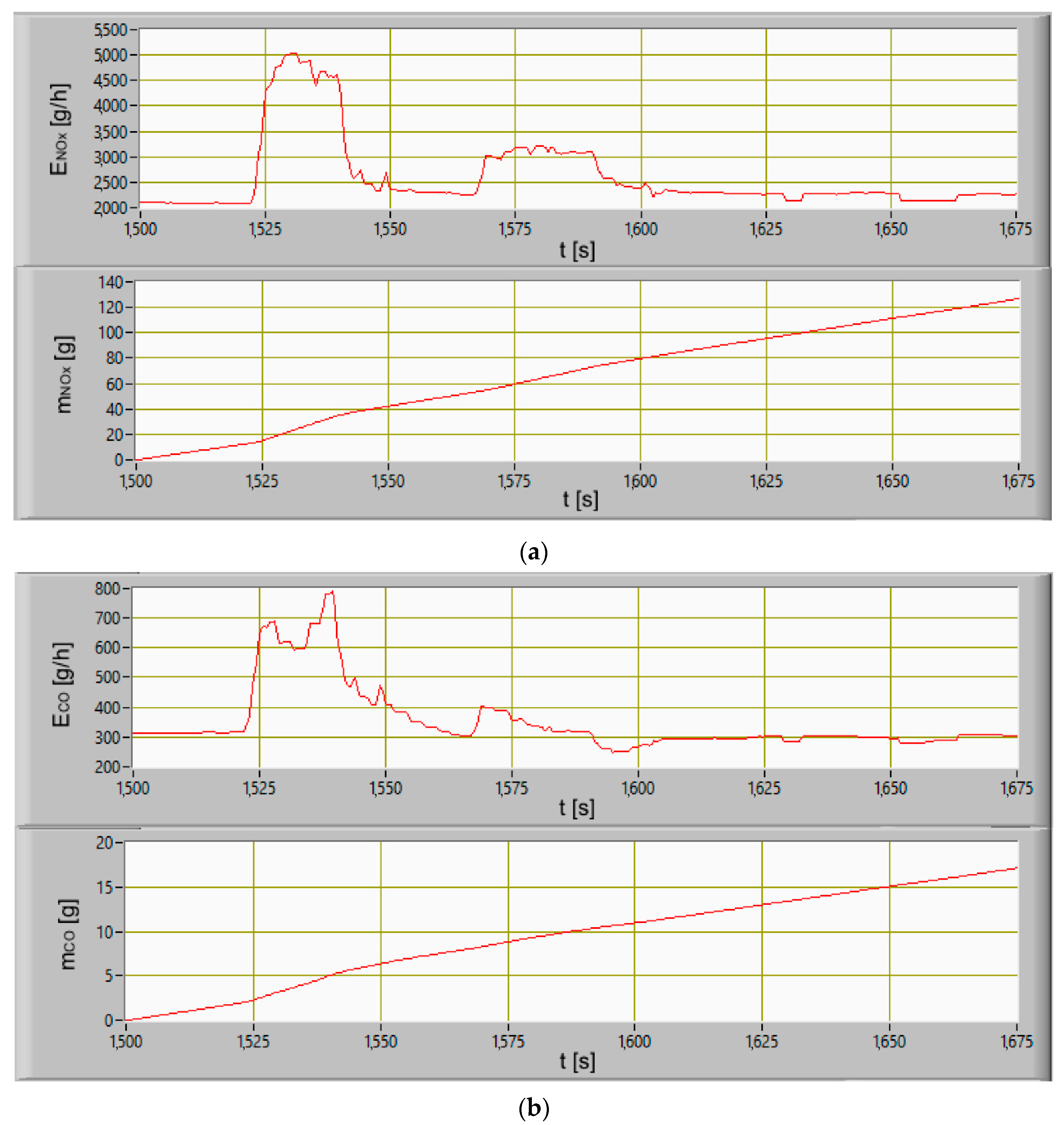
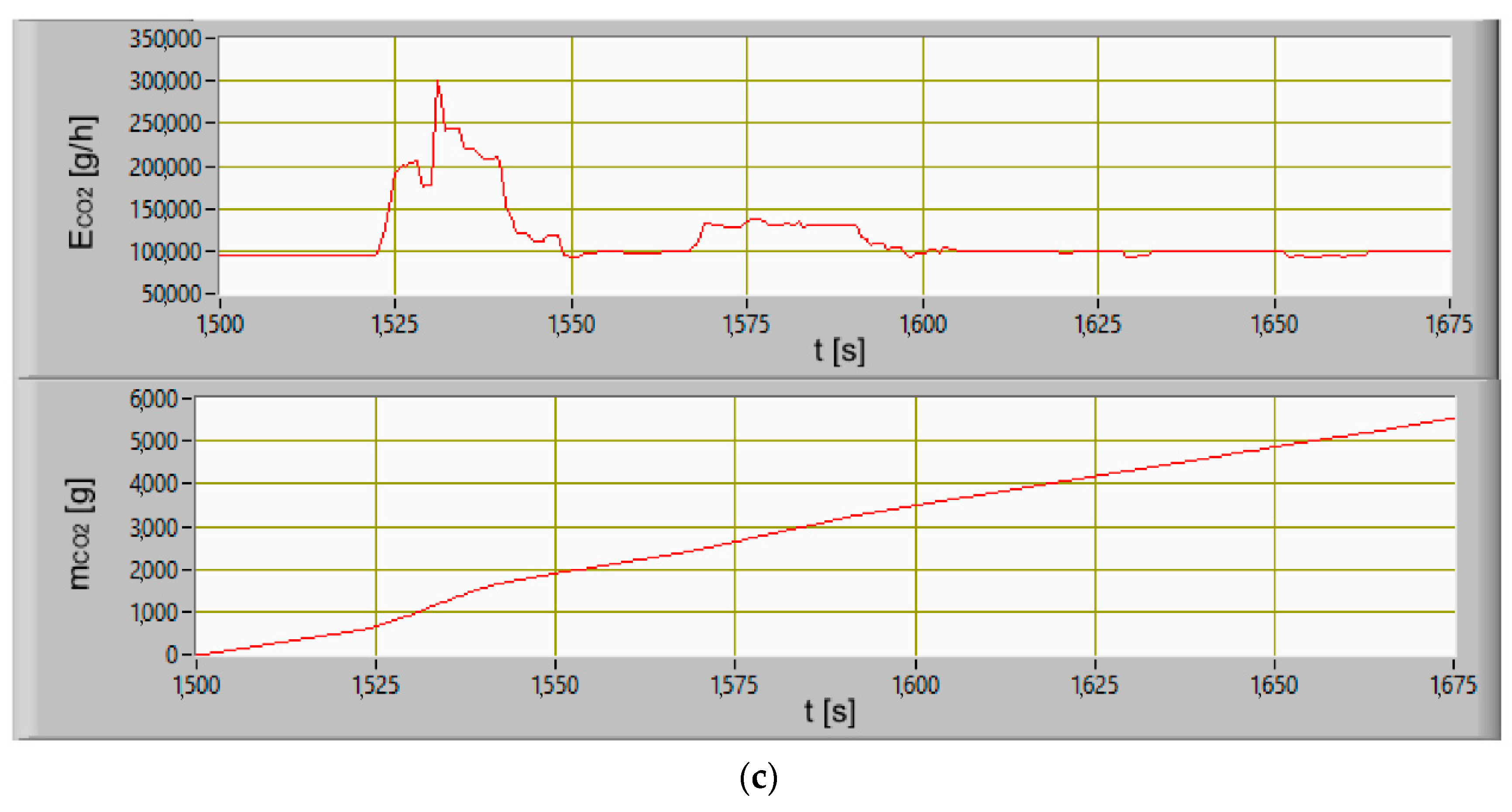






| Specification | |
|---|---|
| Standard displacement | 1145 t |
| Full displacement | 1214 t |
| Length overall | 61.6 m |
| Breadth | 10.8 m |
| Draught | 3.3 m |
| Speed | 13.7 w |
| Main engines | 2 × SULZER type 6AL25/30 |
| Generators | 3 × WOLA39H12 |
| Specification | |
|---|---|
| Piston arrangement | Inline |
| Cylinder diameter | 250 mm |
| Piston stroke | 300 mm |
| Displacement volume | 1 cyl.—14.726 dm3 |
| Nominal power | 706.08 kW |
| Starter | pressure compressed air—3 MPa |
| Number of cylinders | 6 |
| Number of valves per cylinder | 4 |
| Parameter | Measuring Range | Tolerance |
|---|---|---|
| Temperature range | from −40 to + 1000 °C | max. ± 5 °C |
| Oxygen range | from 0 to 25% | According to MARPOL, Annex VI or NOx Technical Code |
| Carbon monoxide range | from 0 to 3000 ppm | |
| Nitrogen monoxide range | from 0 to 3000 ppm | |
| Nitrogen dioxide range | from 0 to 500 ppm | |
| Sulphur dioxide range | from 0 to 3000 ppm | |
| Carbon dioxide range | from 0 to 40% | |
| Absolute pressure range | from 600 to 1150 hPa | ±5 hPa w 22 °C ±10 hPa w −5 do +45 °C |
| Specification | |
|---|---|
| Chipset | SiRF STAR IV GSD4e |
| Frequency | L1; 1575.42 MHz |
| C/A code | 1.023 MHz chip rate |
| Channels | 48 |
| Sensitivity | −163 dBm |
| Accuracy position | <2.5 m 2D RMS SBAS Enable |
| Velocity | 0.1 m/s |
| Time | 1 µs synchronized to GPS time |
| Specification | |
|---|---|
| Pressure range | 0–25 MPa |
| Maximum indicated pressure | 30 MPa |
| Sensitivity | 2 mV/MPa |
| Resonant frequency | 60 kHz |
| Temperature range | 223–623 K |
| Temperature drift 473, …, 500 K | 3.5% |
| Specification | |
|---|---|
| Channels | 16 analog input, 2 analog output |
| Resolution | 12 bits |
| Max. sampling rate | 150 kS/s max |
| FIFO size | 1024 samples |
| Sampling mode | Software, onboard programmable pacer, and external |
| Bipolar Absolute Accuracy (% of FSR) | ±10 ± 5 ± 2.5 ± 1.25 ± 0.625 0.1 0.1 0.2 0.2 0.4 |
| The Stage | Distance [NM] |
|---|---|
| No. 1 | 0.039 |
| No. 2 | 0.15 |
| No. 3 | 0.21 |
| No. 4 | 1.1 |
| Sum: | 1.499 |
| The Stage | The Concentration | The Durbin–Watson Test |
|---|---|---|
| No. 2 | 0.694121033 | |
| 0.215164508 | ||
| 0.203601472 | ||
| 0.390373856 | ||
| No. 3 | 0.467848069 | |
| 0.857018339 | ||
| 0.463965328 | ||
| 0.626851209 | ||
| No. 4 | 0.471728494 | |
| 0.868353646 | ||
| 0.149970084 | ||
| 0.778670739 |
Publisher’s Note: MDPI stays neutral with regard to jurisdictional claims in published maps and institutional affiliations. |
© 2020 by the authors. Licensee MDPI, Basel, Switzerland. This article is an open access article distributed under the terms and conditions of the Creative Commons Attribution (CC BY) license (http://creativecommons.org/licenses/by/4.0/).
Share and Cite
Bogdanowicz, A.; Kniaziewicz, T. Marine Diesel Engine Exhaust Emissions Measured in Ship’s Dynamic Operating Conditions. Sensors 2020, 20, 6589. https://doi.org/10.3390/s20226589
Bogdanowicz A, Kniaziewicz T. Marine Diesel Engine Exhaust Emissions Measured in Ship’s Dynamic Operating Conditions. Sensors. 2020; 20(22):6589. https://doi.org/10.3390/s20226589
Chicago/Turabian StyleBogdanowicz, Artur, and Tomasz Kniaziewicz. 2020. "Marine Diesel Engine Exhaust Emissions Measured in Ship’s Dynamic Operating Conditions" Sensors 20, no. 22: 6589. https://doi.org/10.3390/s20226589
APA StyleBogdanowicz, A., & Kniaziewicz, T. (2020). Marine Diesel Engine Exhaust Emissions Measured in Ship’s Dynamic Operating Conditions. Sensors, 20(22), 6589. https://doi.org/10.3390/s20226589





